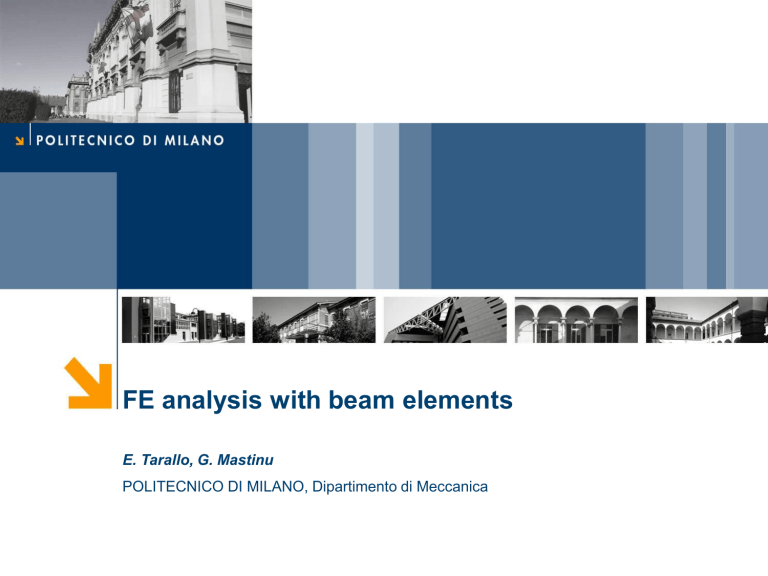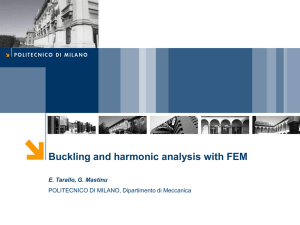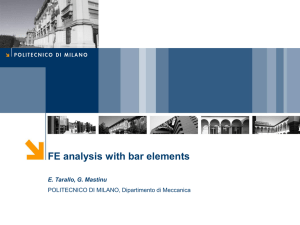Beam element - Politecnico di Milano

FE analysis with beam elements
E. Tarallo, G. Mastinu
POLITECNICO DI MILANO, Dipartimento di Meccanica
Summary
Subjects covered in this tutorial
An introduction to beam elements
A guided example to evaluate a simple structure through the use of FEM
Comparison analytical vs numerical solutions
Other few exercises (to include in exercises-book)
2
Beam element – topic
3
The element library in Abaqus contains several types of beam elements
A “beam” is an element in which assumptions are made so that the problem is reduced to one dimension mathematically: the primary solution variables are functions of position along the beam axis only (as bar element)
A beam must be a continuum in which we can define an axis such that the shortest distance from the axis to any point in the continuum is small compared to typical lengths along the axis
The simplest approach to beam theory is the classical Euler-Bernoulli assumption, that plane cross-sections initially normal to the beam's axis remain plane, normal to the beam axis, and undistorted ( called B23, B33 )
The beam elements in AbaqusCAE allow “transverse shear strain”
(Timoshenko beam theory); the cross-section may not necessarily remain normal to the beam axis. This extension is generally considered useful for thicker beams, whose shear flexibility may be important ( called B21, B22,
B31, B32 and PIPE )
Beam element – shape function
4
Classic mechanical approach uses 3 rd order interpolation function
(elastic line theory)
To follow this theory use element B23, B33
Beam defined in Abaqus
CAE has linear or quadratic interpolation function (element B21,
B22, B31, B32)
Beam element – topic (stiffness matrix)
5
Let us consider an Euler-Bernoulli beam:
F x
1
F y
1
M
1
F x
2
F y
2
M
2
T
k
x
1 y
1
1 x
2 y
2
2
T where the stiffness matrix is: k
EA
0
0
AE
0
0
/
/
L
L
0
12 EJ / L
3
6 EJ / L
2
0
12 EJ / L
3
6 EJ / L
2
0
6 EJ / L
2
4 EJ / L
0
6 EJ / L
2
2 EJ / L
EA / L
0
0
EA / L
0
0
0
12 EJ / L
3
6 EJ / L
2
0
12 EJ / L
3
6 EJ / L
2
6
2
4
EJ
0
EJ
0
6 EJ
EJ
/
/
/
/
L
2
L
L
L
2
Exercise 1 – data problem
6
Geometry: L=1 m;
A=100x100 mm
Material: E=210 GPa;
ν=0.3
Load: p=1 N/mm
Write the relation of internal load e solve the analytic problem of the deformed shape of the isostatic beam
M v ( x
p
( x
L )
2
2
)
p
( x
L )
4
24
p
L
3
6
( x
L )
p
L
4
8
EI
Exercise 1 – Results (analytic vs numeric)
7
FEM Results
Exact solution: v
2
=-0.07142mm
θ
2
=-9.52381 e-5 rad
M
1
= 5e5Nmm
F
1Y
=1000N
Comparison btw analytic solution and FEM results
Note: sensitive variables are
Number of elements
Linear or quadratic order
1
Exercise 1 – Modeling geometry and property
2 3
8
5
4
Exercise 2 – data problem
9
Geometry: L=1 m;
A=100x100 mm
Material: E=210 GPa;
ν=0.3
Load: p=1 N/mm
Write the relation of internal load e solve the analytic problem of the deformed shape of the iperstatic beam
M v ( x
p
)
p
( x
2
L ) 2
3
8 pL ( x
L x
2
( L
48 EI x )
( 3 L
2 x )
)
Exercise 2 – Results (analytic vs numeric)
10
FEM Results
Exact solution:
θ
2
=-1.1904e-5 rad
F
1
=625N
F
2
=375N
M
1
=1.25e5 Nmm
Comparison btw analytic solution and FEM results
Note: sensitive variables are
Number of elements
Linear or quadratic order
Excercise 3 - data
A1
F2
A2
A1
A2
A4 A3
F1
A3
P
11
Material Property:
E=210GPa
Forces:
F1=-20kN (Z)
F2=30kN(Y)
P=80N/mm(X)
Note:
All the written dimensions are
500mm
Problem:
Solve the system and report max displacement and max stress
A4
Exercise 3 - results
12
Excercise 4
13
L
P
H
Geometry: L=1m, H=0.2 m, Section variable
Material: E=206 000 MPa, ν=0.3 (steel)
Load: P=10 kN
Compare max stress and displacement of the structures used in the previous lesson using beam elements










